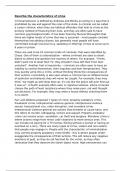Exam (elaborations)
A* Answers for EDUQAS/WJEC A-Level Component 3 PSYCHOLOGY
- Institution
- WJEC
Includes all the 10 mark describe and evaluate questions they can ask you. Including all the methods of modifying, biological explanations, social explanations and individual differences explanations. A* answers from written notes and the textbook
[Show more]



